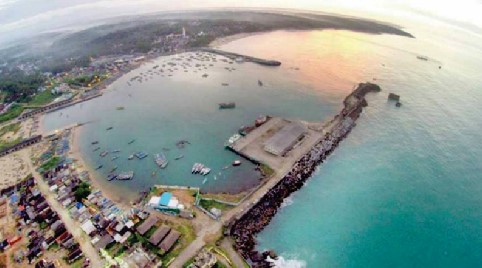
Vizhinjam port
- February 14, 2023
- 0
What will be the advantages for India from the project?
As a country, we are not having a deep port or transshipment port. As a result, our transshipment process is being done at ports like Colombo, Singapore, Dubai and Salalah. The cargo meant for our country is being handled in these ports as we are not having such deep water ports or facilities.
Vizhinjam has a natural advantage because we have an international shipping route running very close to the port. We have a natural water depth of around 20 meters very close to the shore. The port also requires hardly any maintenance dredging. It is also very strategically located as far as the Indian peninsula is concerned.
The areas cited as getting affected due to the project have a long history of severe coastal erosion, well before the port work began in April 2016.
What is the economic loss that we are suffering?
Around 95 per cent of India’s foreign trade is conducted through the sea. In value terms, this works out to 70 per cent of the foreign trade. Nearly 30 per cent of the freight movement takes place through the international shipping route south of the Indian peninsula, which passes 10 nautical miles off Vizhinjam. Despite all these advantages, we got delayed in its implementation. Other countries are taking advantage of this. This results in huge loss of foreign exchange and revenue, which is estimated to be around Rs.2500 crores per year.
We are receiving cargo through feeder ships from Colombo and other countries so our manufacturing and shipping cost is also increasing. With the completion of Vizhinjam port, we will be able to get rid of this serious problem. Due to good road and rail connectivity instead of feeders, containers can be moved through land to about four southern states from this port. Our initial planned capacity is 1 million TEU, subsequently; it will be developed by the concessionaire. Depending on the demand, the final capacity of the port will be 3 to 4 million TEUs.
यदि यह परियोजना चालू हो जाती है, तो एक देश के रूप में भारत को क्या लाभ होंगे?
एक देश के रूप में, हमारे पास गहरे बंदरगाह या पोत बदलने वाले बंदरगाह (ट्रांसिपमेंट प्रक्रिया) नहीं है। नतीजतन, हमारी ट्रांसिपमेंट प्रक्रिया कोलंबो, सिंगापुर, दुबई और सलालाह जैसे बंदरगाहों पर की जा रही है। हमारे देश में आने वाले सामानों को इन बंदरगाहों पर रखा जा रहा है क्योंकि हमारे पास इतने गहरे पानी के बंदरगाह या सुविधाएं नहीं हैं।
बंदरगाह के बहुत करीब एक अंतराष्ट्रीय समुद्री मार्ग होने के कारण विझिंजम को एक प्राकृतिक प्रोत्साहन मिलता है। हमारे पास तट के बहुत करीब लगभग 20 मीटर की प्राकृतिक जल गहराई है। बंदरगाह को शायद ही किसी रखरखाव ड्रेजिंग की आवश्यकता होती हैं। जहां तक भारतीय प्रायद्वीप की बात है, यह बहुत रणनीतिक रूप से स्थित है।
अप्रैल 2016 में बंदरगाह परियोजना का काम शुरू होने से पहले, कई क्षेत्र गंभीर तटीय कटाव के कारण प्रभावित हो रहे थे।
देश को कितना आर्थिक नुकसान हो रहा है?
भारत का लगभग 95 फीसदी विदेशी व्यापार समुद्र के माध्यम से होता है। मूल्य के संदर्भ में, यह विदेशी व्यापार का 70 फीसदी हिस्सा है। लगभग 30 फीसदी माल ढुलाई भारतीय प्रायद्वीप के दक्षिण में अंतरराष्ट्रीय शिपिंग मार्ग के माध्यम से होती है, जो विझिंजम से 10 समुद्री मील दूर है।
इन सभी फायदों के होते हुए भी हमें इसे लागू करने में देरी हुई। जिसका फायदा दूसरे देश उठा रहे हैं। इसके परिणामस्वरूप विदेशी मुद्रा और राजस्व का बड़ा नुकसान होता है, जिसका अनुमान लगभग 2500 करोड़ रूपये प्रति वर्ष है। हम कोलंबो और अन्य देशों से फीडर जहाजों के माध्यम से कार्गाें प्राप्त कर रहे हैं इसलिए हमारी निर्माण और शिपिंग की लागत भी बढ़ रही हैं।
विझिंजम बंदरगाह के पूरा होने से हम इस गंभीर समस्या से निजात पा सकेंगे। फीडर के बजाय अच्छी सड़क और रेल कनेक्टिविटी होने के कारण इस बंदरगाह से लगभग चार दक्षिणी राज्यों में जमीन के माध्यम से कंटेनरों को ले जाया जा सकता हैं। हमारी प्रारंभिक नियोजित क्षमता 10 लाख टीईयू है, बाद में, इसे कंसेसिनेयर द्वारा विकसित किया जाएगा। मांग के आधार पर बंदरगाह की अंतिम क्षमता 30 से 40 लाख टीईयू होगी ।

































































